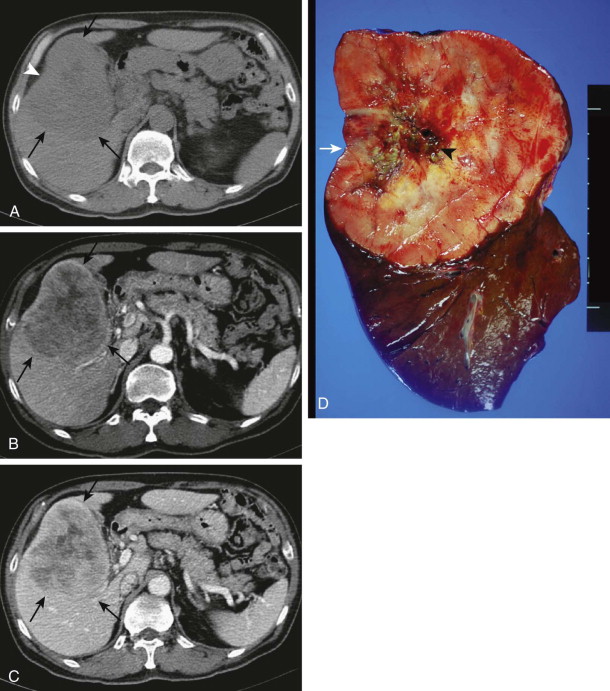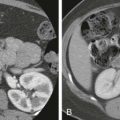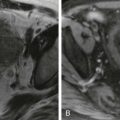Chapter Outline
Other Malignant Gallbladder Neoplasms
Cystic Bile Duct Neoplasms: Cystadenoma and Cystadenocarcinoma
Other Malignant Neoplasms of the Bile Ducts
Most neoplasms that arise from the gallbladder and bile ducts are malignant. Although infrequent, gallbladder and bile duct carcinomas are not rare. Gallbladder carcinoma is the seventh most common malignant neoplasm of the gastrointestinal tract and the most common biliary malignant neoplasm; bile duct carcinoma occurs less often. Familiarity with the imaging characteristics of gallbladder and bile duct neoplasms is important to expedite diagnosis and appropriate treatment of patients, who often present with nonspecific symptoms of right upper quadrant pain, jaundice, and weight loss.
Gallbladder Carcinoma
Epidemiology
Carcinoma of the gallbladder is responsible for at least 3000 deaths per year in the United States. Gallbladder cancer is the sixth most common cancer of the digestive system but accounts for only 3% to 4% of all gastrointestinal cancers. Carcinoma of the gallbladder is two to three times more common in women than in men, and its incidence steadily increases with age, although it varies greatly in different parts of the world. More than 90% of patients are older than 50 years; the peak incidence is 70 to 75 years. Some geographic areas have a high incidence of gallbladder cancer, including South America and India. Certain groups, such as Israelis, Native Americans, Spanish Americans in the southwest United States, and Eskimos in Alaska, have a significantly higher incidence of gallbladder carcinoma and cholelithiasis than do populations.
Etiology
Several factors have been associated with an increased risk for development of gallbladder carcinoma. The presence of gallstones is considered to be an important risk factor for gallbladder carcinoma. Of patients with gallbladder carcinoma, 65% to 90% have gallstones, an incidence considerably higher than that for age- and sex-matched control groups. Many gallbladder cancers are unsuspected and found incidentally during surgery for gallstones or on final histologic analysis of the specimen. Diffuse mural calcification, the “porcelain” gallbladder, is another predisposing factor, ranging from 20% to 50% leading to cancer. Other risk factors include the presence of gallbladder adenomas, an anomalous pancreaticobiliary duct junction, and exposure to carcinogenic chemicals.
Pathologic Findings
Most carcinomas of the gallbladder are adenocarcinomas (85%-90%) and can be papillary, tubular, mucinous, or signet cell type. The remainder are anaplastic, squamous cell, or adenosquamous carcinomas. On macroscopic examination, carcinomas of the gallbladder can appear as poorly defined areas of diffuse gallbladder wall thickening (infiltrating), often with a desmoplastic reaction, or as a cauliflower mass (fungating) that grows into the gallbladder lumen. The infiltrating type invades the gallbladder wall and ultimately replaces the lumen with a tumor mass. The papillary form grows into and eventually fills the lumen. Some tumors may show a combination of the infiltrating and fungating patterns. Approximately 60% of carcinomas originate in the fundus, 30% in the body, and 10% in the neck. In some cases, the tumor may diffusely infiltrate the entire gallbladder, making its organ of origin impossible to identify.
The gallbladder has unique anatomic features; the wall consists of a mucosa, lamina propria, smooth muscle layer, perimuscular connective tissue, and serosa without a submucosa. Furthermore, no serosa exists at the attachment to the liver and along the hepatic surface. The connective tissue is continuous with the interlobular connective tissue of the liver. Gallbladder carcinoma is staged surgically by the depth of invasion, extension of disease into adjacent structures, involvement of lymph nodes, and presence of metastases by the American Joint Committee on Cancer TNM staging system ( Box 79-1 ). Invasion of the muscularis mucosa distinguishes T1 from T2 cancers.
Primary Tumor (T)
| TX | Primary tumor cannot be assessed |
| T0 | No evidence of primary tumor |
| Tis | Carcinoma in situ |
| T1 | Tumor invades mucosa or muscle layer |
| T1a | Tumor invades the mucosa |
| T1b | Tumor invades the muscle layer |
| T2 | Tumor invades the perimuscular connective tissue; no extension beyond the serosa or into the liver |
| T3 | Tumor perforates the serosa (visceral peritoneum) and/or directly invades the liver and/or one other adjacent organ or structure such as stomach, duodenum, colon, pancreas, omentum, or extrahepatic bile ducts |
| T4 | Tumor invades main portal vein or hepatic artery or invades two or more extrahepatic organs or structures |
Regional Lymph Nodes (N)
| NX | Regional lymph nodes cannot be assessed |
| N0 | No regional lymph node metastasis |
| N1 | Metastases to nodes along the cystic duct, common bile duct, hepatic artery, and/or portal vein |
| N2 | Metastases to periaortic, pericaval, superior mesenteric artery and/or celiac artery lymph nodes |
Distant Metastasis (M)
| M0 | No distant metastasis |
| M1 | Distant metastasis |
Stage Grouping
| Stage 0 | Tis | N0 | M0 |
| Stage I | T1 | N0 | M0 |
| Stage II | T2 | N0 | M0 |
| Stage IIIA | T3 | N0 | M0 |
| Stage IIIB | T1-3 | N1 | M0 |
| Stage IVA | T4 | N0-1 | M0 |
| Stage IVB | Any T | N2 | M0 |
| Any T | Any N | M1 |
Clinical Findings
Gallbladder carcinoma most often is manifested with right upper quadrant abdominal pain simulating more common biliary and nonbiliary disorders. Weight loss, jaundice, and an abdominal mass are less common presenting symptoms. Patients may have long-standing symptoms of chronic cholecystitis with a recent change in the quality or frequency of the painful episodes. Other common presentations are similar to either acute cholecystitis or symptoms of biliary malignant disease. Hepatomegaly and ascites suggest liver invasion. Gallbladder carcinoma is occasionally an incidental finding on abdominal imaging studies. Elevated serum levels of α-fetoprotein and carcinoembryonic antigen have been reported in association with gallbladder carcinoma.
Radiographic Findings
Traditional plain oral cholecystography and barium studies of the gastrointestinal tract have a limited role in the imaging of gallbladder carcinoma. Abdominal radiographs may show calcified gallstones, porcelain gallbladder, or, rarely, punctate calcifications from mucinous carcinomas. Biliary gas from malignant gallbladder–enteric fistula is another rare finding. The gallbladder fails to opacify in at least two thirds of patients with carcinoma of the gallbladder, usually because of cystic duct obstruction. Barium study findings are abnormal in limited cases, showing displacement or direct invasion of the duodenum or anterior limb of the hepatic flexure.
Ultrasound, computed tomography (CT), and magnetic resonance imaging (MRI) are the most valuable imaging modalities for evaluation of patients with gallbladder carcinoma. Patients with right upper quadrant pain should initially be examined with ultrasound. Ultrasound can detect lesions suggestive of gallbladder cancer, such as a wide polyp base and irregular borders. The diagnostic accuracy of ultrasound in gallbladder cancer is more than 80%, but it has limitations in tumor staging. Ultrasound can be useful for differentiating adenomyomatosis from the wall-thickening type of gallbladder cancer by detecting intramural cystic spaces or echogenic foci within the wall. Doppler imaging can be useful for differentiating polyp from tumefactive sludge by demonstrating blood flow to the polypoid tumors ( Fig. 79-1 ). Endoscopic ultrasound is useful in depicting the depth of tumor invasion and for characterizing polypoid lesions. CT is superior to ultrasound in assessing lymphadenopathy and spread of the disease into the liver, porta hepatis, or adjacent structures and is useful in predicting which patients will benefit from surgical therapy ( Fig. 79-2 ). Although MRI can be useful in assessing the cause of focal or diffuse mural thickening and helps differentiate gallbladder cancer from adenomyomatosis and chronic cholecystitis, magnetic resonance cholangiopancreatography (MRCP) provides more detailed information than ultrasound or CT about biliary involvement of the tumor. In addition, adding diffusion-weighted imaging to the standard MRI protocol may improve sensitivity for distinguishing gallbladder cancers from benign gallbladder diseases with wall thickening ( Fig. 79-3 ). Although direct cholangiographic techniques such as endoscopic retrograde cholangiopancreatography (ERCP) and percutaneous transhepatic cholangiography are of little value in detecting the presence of gallbladder carcinoma, they are helpful in planning the surgical procedure because they can show tumor growth into adjacent intrahepatic ducts or into the common bile duct. The cholangiographic differential diagnosis includes cholangiocarcinoma, metastases, Mirizzi syndrome, and pancreatic carcinoma.
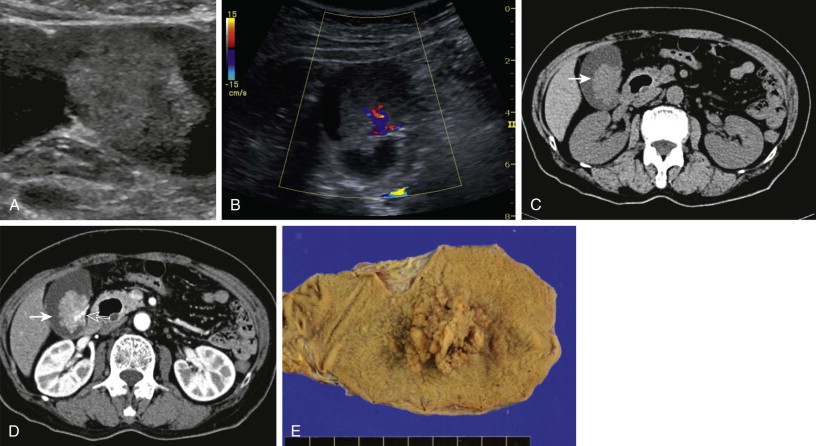
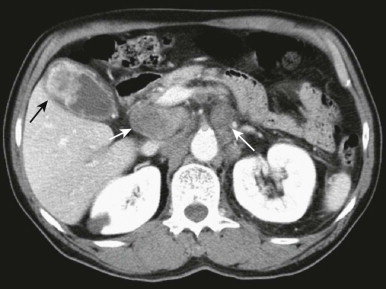
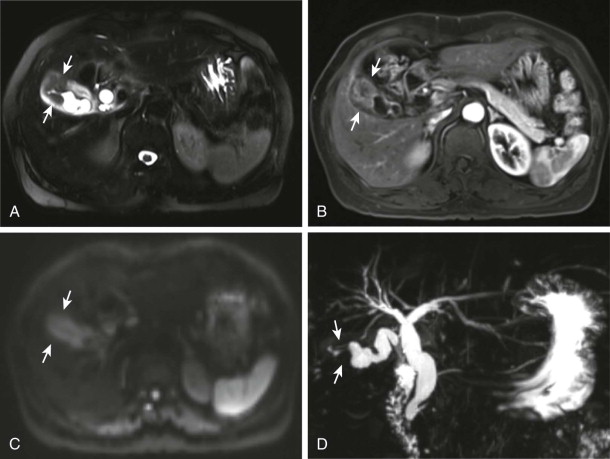
Radiologic Evaluation of the Primary Tumor
Gallbladder carcinomas have three major histologic and imaging presentations: focal or diffuse thickening or irregularity of the gallbladder wall; polypoid mass originating in the gallbladder wall and projecting into the lumen; and most commonly, a mass obscuring or replacing the gallbladder, often invading the adjacent liver.
Carcinoma Manifesting as Mural Thickening.
Focal or diffuse thickening of the gallbladder wall is the least common presentation of gallbladder carcinoma and is the most difficult to diagnose, particularly in the early stages. Gallbladder carcinoma may cause mild to marked mural thickening in a focal or diffuse pattern. This thickening is best appreciated sonographically; the gallbladder wall is normally 3 mm or less in thickness. Carcinomas confined to the gallbladder mucosa may be manifested as flat or slightly raised lesions with mucosal irregularity that are difficult to appreciate sonographically. In one sonographic series, half the patients with these early carcinomas had no protruding lesions, and fewer than one third were identified preoperatively. More advanced gallbladder carcinomas can cause marked mural thickening, often with irregular and mixed echogenicity ( Fig. 79-4 ). The gallbladder may be contracted, normal sized, or distended, and gallstones are usually present. When cancer occurs in the neck portion of the gallbladder, identification of cystic duct involvement by the tumor on imaging merits consideration of focal bile duct resection to achieve a negative resection margin (see Fig. 79-4 ).
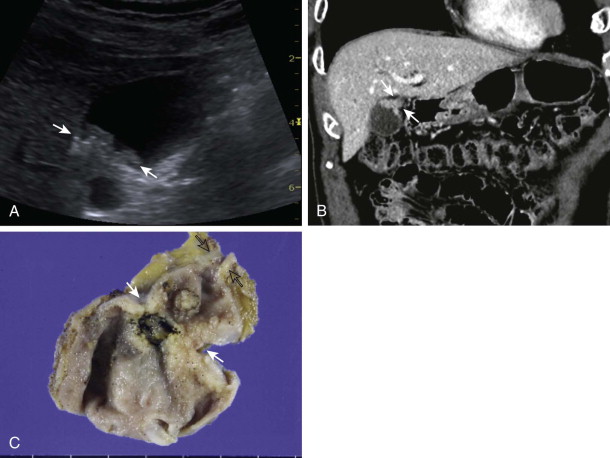
Four factors interfere with the sonographic recognition of carcinoma as the cause of gallbladder wall thickening:
- 1.
Changes of early gallbladder carcinoma may be only subtle mucosal irregularity or mural thickening.
- 2.
Gallbladder wall thickening is a nonspecific finding that can also be caused by acute or chronic cholecystitis, hyperalimentation, portal hypertension, adenomyomatosis, inadequate gallbladder distention, hypoalbuminemia, hepatitis, hepatic failure, cardiac failure, or renal failure. The echo architecture of the wall can sometimes help narrow the differential diagnosis. In acute cholecystitis, the wall often has irregular, discontinuous hypoechoic and echogenic bands. Chronic cholecystitis often results in a uniformly echodense band surrounding the mucosa, and hypoproteinemia may have a hypoechoic central band. Pronounced wall thickening (>1.0 cm) demonstrated by ultrasonography with associated mucosal irregularity or marked asymmetry should raise concerns for malignant disease or complicated cholecystitis.
- 3.
Chronic cholecystitis is often present in patients with gallbladder carcinoma.
- 4.
Shadowing stones or gallbladder wall calcification may obscure the carcinoma.
Although CT is inferior to ultrasound for evaluating the gallbladder wall for mucosal irregularity, mural thickening, and cholelithiasis, it is superior for evaluating the thickness of portions of the gallbladder wall that are obscured by interposed gallstones or mural calcifications on ultrasound. On contrast-enhanced CT, thick (>2.5 mm) and strong enhancement of the inner wall and irregular contour of the affected wall are significant predictors for a malignant cause of gallbladder wall thickening ( Fig. 79-5 ). When focal or irregular thickening of the gallbladder wall is encountered on CT, the images should be carefully inspected for bile duct dilation, local invasion, metastasis, or adenopathy. Multiplanar reformatted images of multidetector CT (MDCT) scans could be valuable for demonstrating extent of gallbladder cancers as well as relationship with adjacent organs, similar to biliary malignant tumors (see Fig. 79-4 ). Studies have also demonstrated that diffusion-weighted MRI could contribute to the improvement of the diagnostic capability for gallbladder wall thickening or polypoid lesions by demonstrating high signal intensity on high b value diffusion-weighted imaging and a lower apparent diffusion coefficient value of gallbladder cancers than that of benign gallbladder diseases (see Fig. 79-3 ).
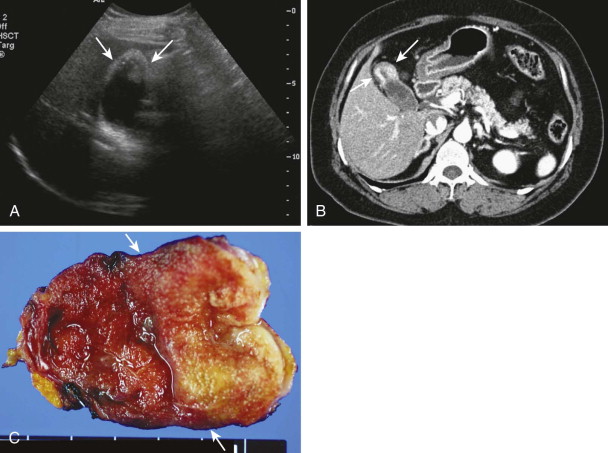
Carcinoma Manifesting as a Polypoid Mass.
About one fourth of gallbladder carcinomas are manifested as a polypoid mass projecting into the gallbladder lumen. Identification of these neoplasms is particularly important because they are well differentiated and are more likely to be confined to the gallbladder mucosa or muscularis when discovered.
Polypoid carcinomas on ultrasound usually have a homogeneous tissue texture, are fixed to the gallbladder wall at their base, and do not cast an acoustic shadow ( Fig. 79-6 ; see also Fig. 79-1 ). Most are broad based with smooth borders, although occasional tumors have a narrow stalk or villous fronds. The polyp may be hyperechoic, hypoechoic, or isoechoic relative to the liver. Gallstones are usually present, and the gallbladder is either normal sized or expanded by the mass. A small polypoid carcinoma can be indistinguishable from a cholesterol polyp, adenoma, or adherent stone. Most benign polyps are small, measuring less than 1 cm. If a gallbladder polyp is larger than 1 cm in diameter and is not clearly benign, cholecystectomy should be considered. Tumefactive sludge or blood clot can simulate a polypoid carcinoma. Positional maneuvers usually differentiate these entities; clots and sludge move, albeit slowly, whereas cancers do not. Color Doppler imaging is also valuable for differentiating a polypoid tumor from tumefactive sludge by demonstrating vascular flow within tumors (see Fig. 79-1 ). When polypoid carcinomas are sufficiently large, they are manifested as soft tissue masses that are denser than surrounding bile on CT scans or show a hypointensity to surrounding bile on T2-weighted MR imaging (see Fig. 79-6 ). The polypoid cancer usually enhances homogeneously after administration of contrast medium, and the adjacent gallbladder wall may be thickened (see Figs. 79-1 and 79-6 ). Necrosis or calcification is uncommon.
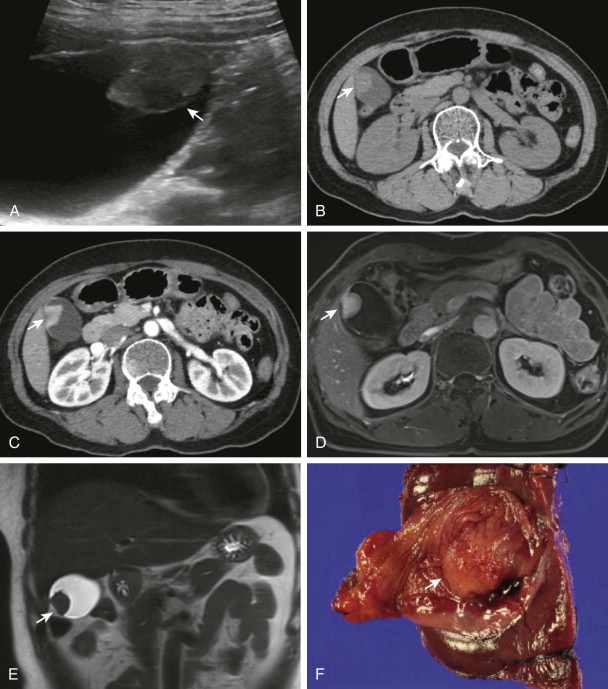
Carcinoma Manifesting as a Gallbladder Fossa Mass.
A large mass obscuring or replacing the gallbladder is the most common (42%-70%) presentation of gallbladder carcinoma. On sonographic examination, the mass is often complex, with regions of necrosis, and small amounts of pericholecystic fluid are often present. Gallstones are commonly seen within the ill-defined mass, which typically invades hepatic parenchyma.
On CT scans, infiltrating carcinomas that replace the gallbladder often show irregular contrast enhancement with scattered regions of internal necrosis ( Fig. 79-7 ). Unless the associated gallstones are densely calcified, they may be difficult to identify. Invasion of the liver or hepatoduodenal ligament, satellite lesions, hepatic or nodal metastases, and bile duct dilation are also common.
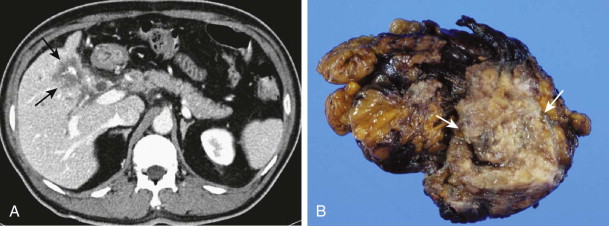
MRI findings in gallbladder carcinoma are similar to those reported with CT. MRI demonstrates prolongation of the T1 and T2 relaxation time in gallbladder carcinoma. These lesions are heterogeneously hyperintense on T2-weighted images and hypointense on T1-weighted images compared with liver parenchyma. Ill-defined early enhancement is a typical appearance of gallbladder carcinoma on dynamic gadolinium-enhanced MRI ( Fig. 79-8 ). MRI with MRCP offers the potential of evaluating parenchymal, vascular, biliary, and nodal involvement with a single noninvasive examination ( Fig. 79-9 ). On the basis of MRI alone, it may be difficult to distinguish carcinoma of the gallbladder from inflammatory and metastatic disease.
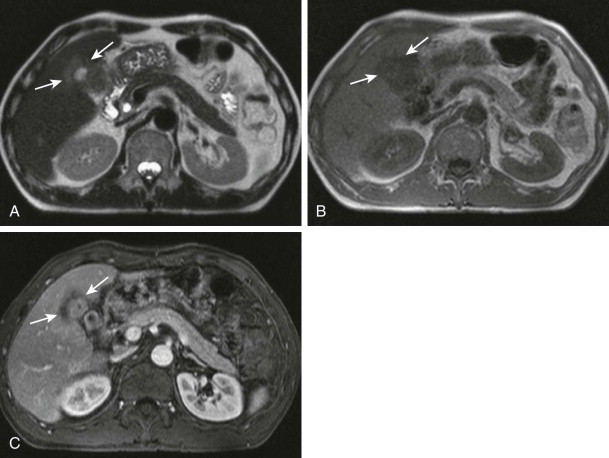
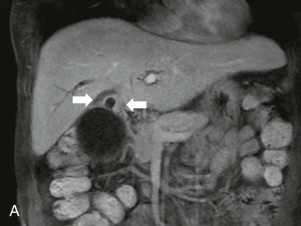
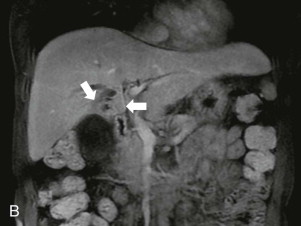
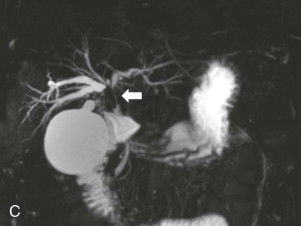
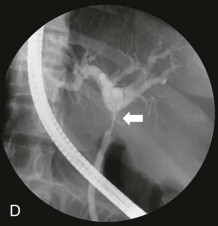
Differential Diagnosis
The differential diagnosis of infiltrating gallbladder carcinomas includes more common inflammatory and noninflammatory causes of wall thickening. These include heart failure, cirrhosis, hepatitis, renal failure, complicated cholecystitis, xanthogranulomatous cholecystitis, and adenomyomatosis. Clinically and radiologically, gallbladder carcinoma can be difficult to differentiate from cholecystitis with pericholecystic fluid and abscess. A increased attenuation intrahepatic halo surrounding the gallbladder wall on contrast-enhanced CT scans or MRI is fairly specific for complicated cholecystitis. Gallbladder carcinoma should be suspected when there are features of a focal mass, lymphadenopathy, hepatic metastases, and biliary obstruction at the level of the porta hepatis. Diffuse gallbladder wall thickening and streaky densities in the pericholecystic fat are seen with both inflammation and carcinoma. Xanthogranulomatous cholecystitis is a pseudotumoral inflammatory condition of the gallbladder that radiologically simulates gallbladder carcinoma. In the few cases in which it is impossible to distinguish complicated cholecystitis from neoplasm, ultrasound-directed or CT-directed needle biopsy can provide a tissue diagnosis. Adenomyomatosis, which is characterized by focal or diffuse gallbladder wall thickening with dilated Rokitansky-Aschoff sinuses, may simulate gallbladder carcinoma on CT. MRI can be useful for distinguishing this entity from gallbladder carcinoma.
The differential diagnosis of those tumors that are manifested as an intraluminal polypoid mass includes adenomatous, hyperplastic, and cholesterol polyps; carcinoid tumor; metastatic melanoma; and hematoma. The differential diagnosis for a mass replacing the gallbladder fossa includes hepatocellular carcinoma, cholangiocarcinoma, and metastatic disease to the gallbladder fossa. Hepatomas occurring near the gallbladder fossa may be confused with gallbladder cancer radiographically, but they usually occur in cirrhotic livers and do not typically invade the gallbladder. Patients with liver metastases to the gallbladder fossa usually have a known primary neoplasm.
Pathways of Tumor Spread
Gallbladder carcinoma spreads beyond the wall by several routes: direct invasion of the liver, hepatoduodenal ligament, duodenum, or colon; lymphatic spread to regional lymph nodes; hematogenous spread to the liver; intraductal tumor extension; and metastasis to the peritoneum. Distant metastases are unusual.
Gallbladder carcinoma spreads most commonly by direct invasion of the liver. Liver invasion is facilitated by its proximity and the thin gallbladder wall, which lacks a submucosa and has only a single muscle layer. Invasion of the gastrohepatic ligament is also common and may cause biliary obstruction at the porta hepatis. Invasion into the duodenum or colon is less common. On ultrasound images, the gallbladder wall becomes ill-defined as an inhomogeneous mass extends into the liver parenchyma. On CT scans, portions of the invading tumor show enhancement after administration of contrast medium. The gallbladder wall is poorly defined adjacent to the carcinoma invading liver parenchyma. Detection of subtle hepatic invasion is improved by use of narrow collimation to avoid partial volume averaging and by coronal or sagittal reformations. On MRI, direct hepatic invasion and distant liver metastases are well shown on T2-weighted or gadolinium-enhanced images. The tumor has the same signal intensity as the primary tumor in most cases.
The prevalence of lymphatic spread is high in gallbladder carcinoma (see Fig. 79 – 2 ). Lymphatic metastases progress from the gallbladder fossa through the hepatoduodenal ligament to nodal stations near the head of the pancreas. The cystic and pericholedochal lymph nodes are the most commonly involved at surgery and are a critical pathway to involvement of the celiac, superior mesenteric, and para-aortic lymph nodes. Because the gallbladder drains into these more distal nodes, hepatic hilar nodes are usually not involved. Positive lymph nodes are more likely to be greater than 10 mm in anteroposterior diameter and have heterogeneous contrast material enhancement.
Dilated bile ducts are present in about half the patients at the time of presentation. Biliary obstruction may develop in patients with gallbladder cancer for a variety of reasons: lymphadenopathy, usually surrounding the common bile duct; tumor invasion into the hepatoduodenal ligament, often at the porta hepatis (see Fig. 79-9 ); intraductal tumor growth; or rarely, choledocholithiasis. Adenopathy and invasion into the hepatoduodenal ligament are the most common causes of obstruction; intraductal spread is infrequent but may be seen as a polypoid mass extending into the common bile duct. Ultrasound, CT, and MRI reveal biliary dilation and can usually show the level of obstruction. Invasion of the hepatoduodenal ligament is often better demonstrated with coronal reformatted CT or MRI than with axial CT.
Treatment and Prognosis
Survival in patients with gallbladder carcinoma is strongly influenced by the pathologic stage at presentation. Patients with cancer limited to the gallbladder mucosa have an excellent prognosis, but most patients with gallbladder carcinoma have advanced, unresectable disease at the time of presentation. As a result, less than 15% of all patients with gallbladder carcinoma are alive after 5 years. Surgical management of gallbladder carcinoma is based on the local extension of the tumor. If there is direct extension of disease to the muscularis propria, a radical cholecystectomy is necessary. When disease extends through the serosa, more radical procedures including extended cholecystectomy, pancreatoduodenectomy, and major hepatic resection can be performed. However, radical tumor resection in this setting is associated with a high operative mortality and few long-term survivors.
Other Malignant Gallbladder Neoplasms
A number of malignant diseases can metastasize to the gallbladder. Among the most common primary malignant neoplasms are melanoma, breast carcinoma, hepatocellular carcinoma, and lymphoma. On cross-sectional images, metastases show focal wall thickening, one or more polypoid masses, or replacement of the gallbladder by neoplasm ( Fig. 79-10 ). Metastatic neoplasms of the gallbladder may be indistinguishable from primary gallbladder carcinoma except that gallstones are less frequently seen in patients with metastases.
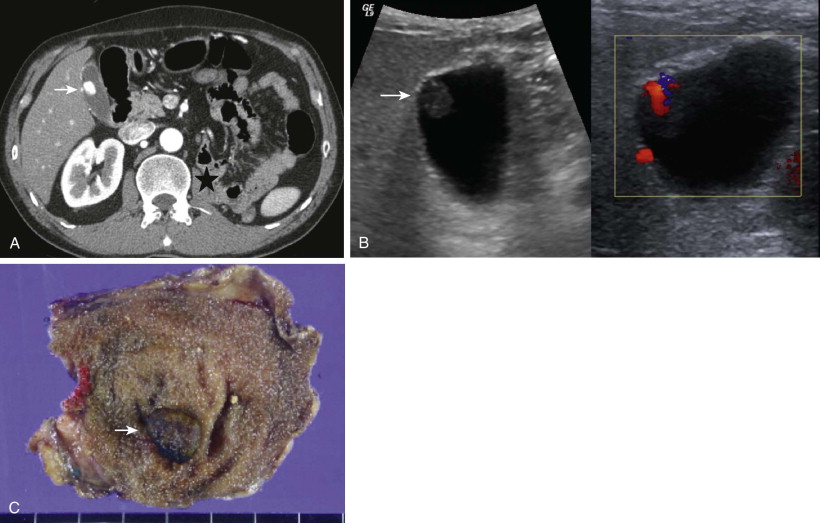
Primary carcinoid tumors, lymphomas, and sarcomas of the gallbladder have also been reported. Carcinoids and lymphomas are manifested as polypoid masses that sometimes obstruct the cystic duct. Sarcomas are bulky polypoid masses that are indistinguishable from primary gallbladder carcinoma.
Benign Gallbladder Neoplasms
A diverse spectrum of benign tumors arise from the gallbladder. Benign neoplasms are derived from the epithelial and nonepithelial structures that compose the normal gallbladder. Although these lesions are relatively uncommon, their importance lies in their ability to mimic malignant lesions of the gallbladder. Most benign neoplasms of the gallbladder are adenomas. At gross examination, gallbladder adenomas appear as polypoid structures and may be sessile or pedunculated. They are generally smaller than 2 cm. Tubular adenomas are typically lobular in contour, whereas papillary adenomas have a cauliflower-like appearance.
On ultrasound, adenomas appear as small, broad-based, nonshadowing, sessile or pedunculated polypoid filling defects that do not move with gravitational maneuvers. The echotexture of adenomas is typically homogeneous and hyperechoic. Adenomas tend to be less echogenic and more heterogeneous as they increase in size ( Fig. 79-11 ). Focal gallbladder wall thickening adjacent to a polypoid mass should raise concern for malignant disease. These polyps are manifested as enhancing intraluminal soft tissue masses. They are difficult to distinguish from the more common cholesterol polyp. Cholesterol polyps are more often smaller and multiple. Other rare benign neoplasms of the gallbladder include cystadenoma, granular cell tumors, hemangioma, lipoma, and leiomyoma.
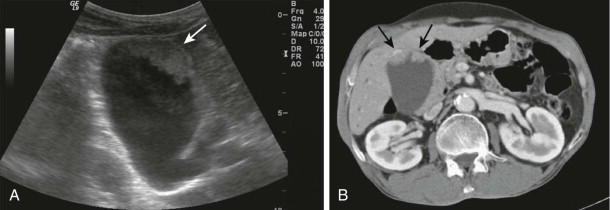
Cholangiocarcinoma
Epidemiology
Cholangiocarcinoma is a malignant tumor arising from the epithelium of the bile ducts and is the second most common primary hepatobiliary cancer after hepatocellular carcinoma. Cholangiocarcinoma is an uncommon tumor; between 2500 and 3000 new cases of cholangiocarcinoma are diagnosed annually in the United States. This tumor is more prevalent in the Far East and Southeast Asia, where liver fluke infection and choledocholithiasis are common. Cholangiocarcinomas occur slightly more often in men, with a male-to-female ratio of 1.3 : 1; the average age at diagnosis is between 50 and 70 years. Risk factors for this neoplasm include primary sclerosing cholangitis, choledochal cyst, familial polyposis, congenital hepatic fibrosis, bile duct stone disease, prior biliary-enteric anastomosis, infection with the Chinese liver fluke Clonorchis sinensis , and history of exposure to thorium dioxide (Thorotrast).
Pathologic Findings
More than 95% of cholangiocarcinomas are adenocarcinomas originating from bile duct epithelium. Most cholangiocarcinomas are well to moderately differentiated adenocarcinomas with a tendency to develop desmoplastic reactions and early perineural invasion. Cholangiocarcinoma is classified anatomically into three groups: intrahepatic and peripheral to the liver hilum, hilar, or extrahepatic. These three types of cholangiocarcinoma are regarded as distinct disease entities therapeutically. Intrahepatic tumors are treated with hepatectomy, when possible, and hilar tumors are managed with resection of the bile duct, preferably with hepatectomy. Extrahepatic tumors are treated in a fashion similar to other periampullary malignant neoplasms with pancreatoduodenectomy. Although their precise definitions are controversial, a tumor that arises peripheral to the secondary bifurcation of the left or right hepatic duct is considered an intrahepatic cholangiocarcinoma. A tumor that arises from one of the hepatic ducts or from the bifurcation of the common hepatic duct is classified as a hilar cholangiocarcinoma. Peripheral intrahepatic cholangiocarcinoma accounts for 10% of all cholangiocarcinomas, hilar cholangiocarcinoma for 25%, and extrahepatic cholangiocarcinoma for 65%.
Cholangiocarcinomas are also divided into three types on the basis of their morphology: mass forming; periductal infiltrating, causing stricture; and intraductal growing. This morphologic classification of cholangiocarcinoma is of great importance as it reflects biologic behavior and mode of spread of the tumor, and different types of cholangiocarcinoma may need different staging systems or different treatment strategies Mass-forming intrahepatic cholangiocarcinoma is a gray-white mass often accompanied by satellite nodules ( Fig. 79-12 ). Fibrosis and necrosis are frequently seen centrally. The periductal infiltrating type of cholangiocarcinoma grows along the bile duct wall, resulting in concentric mural thickening and proximal dilation. A dense fibroblastic reaction may encase the adjacent hepatic artery or portal vein, complicating surgical resection ( Fig. 79-13 ). Intraductal growing papillary cholangiocarcinoma is characterized by the presence of intraluminal papillary tumors of the intrahepatic or extrahepatic bile ducts with partial obstruction and dilation of the bile ducts ( Fig. 79-14 ). The tumors are usually small but often spread superficially along the mucosal surface, resulting in multiple tumors along the adjacent segments of the bile ducts or a tumor cast. Some papillary tumors of the bile ducts produce a large amount of mucin and may impede the flow of bile. Ducts both proximal and distal to the tumor can be dilated because mucin may obstruct the papilla of Vater.

